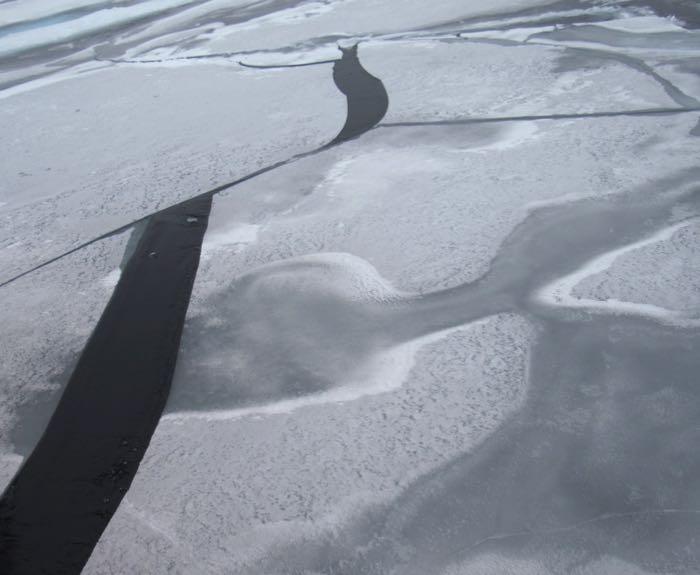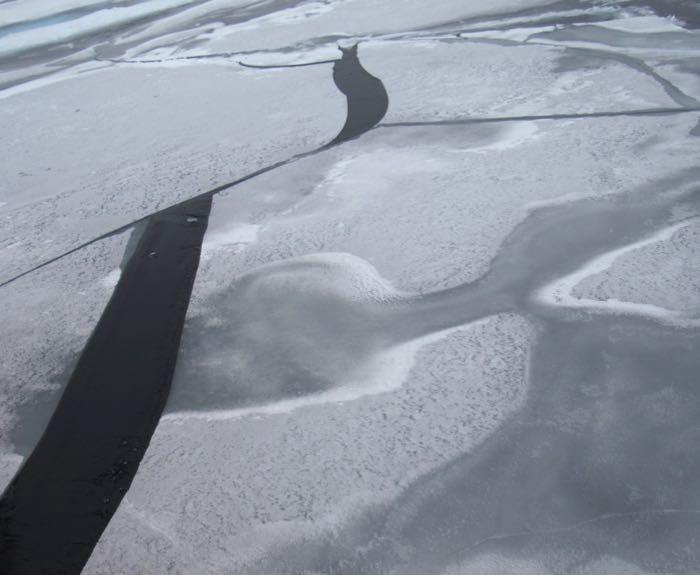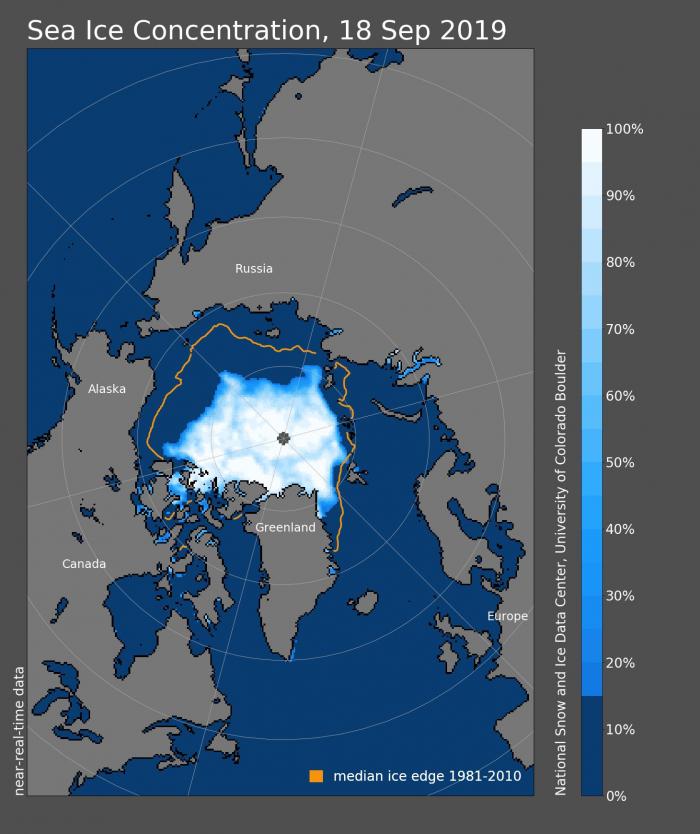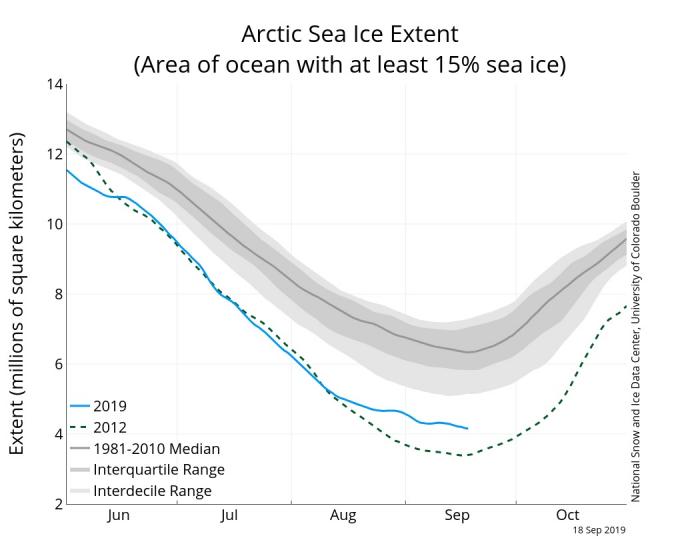We're Ramming the Sea Ice!
I was on my way up to the general meeting when I felt the icebreaker come to a stop. Intrigued, I ran outside to the deck to see what was going on. Ahead of us was a big sea ice floe (single piece of sea ice). The ship was slowing backing up, reversing through the loose chunks of ice it had just broken. "What's happening?" I asked the other people in slippers and t-shirts who had also come outside to see. They explained with excitement, "We're ramming the sea ice!"

After the ship had gone in reverse for about 1/4 of a mile, it switched to forward motion. Starting slowly, we gained momentum heading toward the thick slab of sea ice. We were excited on deck. I laughed and began to chant, "I think we can, I think we can." (That line comes from a favorite book I read as a kid and winter time attempts to drive up our slippery driveway).
The icebreaker collided with the edge of the thick floe. The ship shuddered. Pieces of ice around us rose and fell slowly, like the landscape was taking a deep breathe. Water was pushed under the ice and spilled out through little gaps in the ice. The ice was compressed and folded upwards. And then things started to settle back into place. But a small crack had formed extending through the sea ice toward the horizon. The icebreaker began to back up again for a second attempt.

We were late to the general meeting, so we hurried inside. Then we found out the meeting had been postponed. The cruise leader and support team were busy observing and analyzing the ice as we pushed through the floe. It turns out the 'ramming' was a way to test the floe conditions. I rushed down to grab my hat, coat, mittens, and boots. Then I headed up to the observation deck above the bridge (cabin where the captain and crew steer and navigate the boat). Many of us were gathered there, peering over the railing.
As we hit the sea ice floe for the second time, that crack extended more than a mile into the distance. We continued to motor onward. The icebreaker easily cleared a pathway. It was remarkable. But I noticed that some people weren't quite as excited any more.
Over the course of the evening, it became more and more clear that the ice floe had failed the test. This ice floe picked out using images from a satellite orbiting high over the earth. From that information, it had looked like a decent option for mooring the Polarstern and setting up the research on the ice. But we now knew the reality. Most of it wasn't thick enough, and a lot of it was rotten (a term that refers to sea ice that is water logged and weakened by summer melting). The ice analysts had anticipated this -- that is why they were willing to ram it like this. They needed to get a better look to have more information when analyzing the other ice floe options.

So now we head farther north. The hope is that the floes they have spotted from satellite images will be thicker and stronger there. This is probable since these floes spent the melt season farther north. The air and water temperatures 50-100 kilometers north probably weren't quite as high, so hopefully less of the ice floe thickness melted away in the past 4-5 months of summer.
We are optimistic! If there are good floes of second-year ice to be found, this is one of the best spots in the Central Arctic Ocean to look for them. But the overall picture for sea ice in 2019 is not a good one. Updates about current sea ice conditions in the Arctic are available from the National Snow and Ice Data Center. Before I left Tromso, I checked the information available there.
Typically sea ice in the Arctic reaches is lowest extent in September of each year. This means that the area of the ocean covered with sea ice has shrunk to as small as it will for the year. In September, the pattern usually switches from melting to re-freezing and the extent (area) of the ocean covered by sea ice begins to increase. There are many other ways to measure sea ice, but ice extent at this September sea ice minimum is one key indicator of change in overall ice conditions. This graphic from Thomas Rackow, with the Year of Polar Prediction, does a great job of showing the overall trend (pattern) of decreasing sea ice extent in the Arctic.


In 2012, the September sea ice extent minimum reached a new low. It was less than 4.0 million square kilometers (about 1.5 million square miles) that year. The conditions when I left Tromso were a sea ice extent in the Arctic of about 4.2 million square kilometers (1.6 million square miles) but it was still declining. The September sea ice minimum isn't official yet for 2019 -- it is still to soon to know for sure. However, all of the sea ice researchers here are confident that the extent will be quite small compared to what used to be normal. It may not be as small as it was in 2012, but it will likely be close. Sea iceThere are terms for different types of ice. Shorefast ice forms along coasts and is attached to land. Pack ice is ice floating in open water. Multiyear ice is ice that has survived at least 1 summer. First year ice is ice that has not yet survived a melting season. thickness and concentration (what percentage of a smaller area of water is actually covered with sea ice) are also quite low this year.
This decrease in sea ice creates challenges for the MOSAiC expedition, but also has much broader impacts. For people who live with and depend upon the sea ice, this change can disrupt food systems, cultural lifeways, and social practices. It can make communities more vulnerable to storms and flooding. Changes in sea ice can be dangerous, even fatal, for those who must cross it for hunting or other reasons.
For the rest of the world, decreases in sea ice may have major impacts on overall climate. There are lots of complicated effects, but one simplified example is the link between sea ice decline and warmer Arctic temperatures. As sea ice declines, more of the sun's light is absorbed by the Arctic Ocean. This causes warming, which feeds into more sea ice decline in the Arctic. But this isn't just about the Arctic. We are all connected to the Arctic. It has lots of important roles, but one of the most important parts is that the Arctic helps to regulate temperature and weather patterns elsewhere in the world. As the Arctic changes, it will likely drive some major changes in temperature, precipitation, and severe storms all across the northern hemisphere.
Your Questions and Curiosities
How will they choose the right piece of ice?
In order to moor the Polarstern and set up the sea ice research, they need to find an ice floe that meets lots of criteria. It must be large enough to set up all the equipment and the airstrip. Some equipment needs to be isolated from other components, so the floe needs to be more than 1-2 miles across.
The floe also needs to be thick enough to safely support people and equipment for an entire year -- including the summer melt season. They are looking for about 1-1.5 meters (3-5 feet) thickness near the center of the floe. They are also looking for an area that doesn't have many melt ponds. Melt ponds are areas where meltwater pools on top of the sea ice during the summer season. Melt ponds are dangerous to work around and can cause the ice to break up sooner.
The ice must be fairly consistent in thickness too, so that it is less likely to break up into pieces due to wind or current stress. At the same time, there needs to be enough variability so that the researchers can study and compare different types and thicknesses of ice.
Finally, the ice must be located in the right area. The researchers use predictions of sea ice drift to figure out where the Polarstern should start. They want it to drift across the Central Arctic Ocean and out into the Fram Strait. They don't want it to go towards Alaska or towards the Russian coast. Models and forecasting give them a very good idea of where the ship needs to start in order to accomplish this. So they need to find an ice floe within this target start area.
And that's what they are searching for right now. The perfect piece of ice.
Word of the Day
The basic Russian word for ice is led. In one dialect of Inuit language (Inuktitut), simple ice is called siku.
Education Extension
There are many activities you can do around changes in sea ice. For more information on changes to sea ice in the Alaskan Arctic and the impacts on the people and animals that live there, check out Faces of Climate ChangeA statistically significant variation in either the mean state of the climate or the mean variability of the climate that persists for an extended period (typically 10 years or more). Climate change may result from such factors as changes in solar activity, long-period changes in the Earth's orbital elements, natural internal processes of the climate system, or anthropogenic forcing (for example, increasing atmospheric concentrations of carbon dioxide and other greenhouse gases).. This short video series (5-15 minutes each) includes an Overview of potential climate change impacts on Alaska’s marine ecosystems through interviews with scientists. 2012, interviews about Disappearing Sea Ice with Alaska Native knowledge-bearers and scientists, and highlights of how animal Life on the Ice will be impacted by climate change. You can follow these videos up with one more, Sea Ice Secure to showcase ways in which local people are seeking adaptive ways to go about their subsistence way of life in the wake of rapid change in sea ice conditions.
If you live in a community that depends upon sea ice, you could work with an Elder, knowledge-bearer, community member that works with sea ice, or scientist in your community and invite them to visit the class. Roby Littlefield’s guidelines to Elders in the Classroom is an excellent resource as you work to involve Elders and community members in your classroom activities.
Alaska Sea Grant has a Our Changing World middle school science unit based around changes in sea ice, snowpack, and glacial melt. This is a great series of place-based lessons and activities to use in the classroom, but many can be adapted for other settings as well. Students learn how changes in physical environments affect our ecosystems by investigating how sea ice is changing over time and how melting glaciers affect stream flows, erosion, and habitats for fish and wildlife. They participate in a WebQuest to explore how a warming climate might affect life in the Bering Sea. Students then take a close look at changes in their local environment by interviewing long time residents and observing repeat photographs of the local landscape. Finally they create a digital story to share the potential effects of a warming climate with others.
If you are interested in looking more specifically at feedbacks between warming temperatures and melting sea ice, check out these experiments about Sea Ice and Heat: A Vicious Cycle or Albedo: Measuring the Reflective Properties of Different Surfaces


Comments